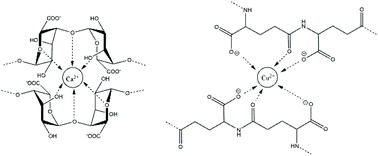Chelate chemistry governs ion-specific stiffening of Bacillus subtilis B-1 and Azotobacter vinelandii biofilms†
Abstract
Unwanted formation of bacterial biofilms can cause problems in both the medical sector and industrial settings. However, removing them from surfaces remains an ongoing challenge since biofilm bacteria efficiently protect themselves from external influences such as mechanical shear forces by embedding themselves into a matrix of extracellular polymeric substances. Here, we discuss microscopic principles, which are responsible for alterations in the viscoelastic properties of biofilms upon contact with metal ions. We suggest that it is a combination of mainly two parameters, that decides if biofilm stiffening occurs or not: the ion size and the detailed configuration of polyanionic macromolecules from the biofilm matrix. Our results provide new insights in the molecular mechanisms that govern the mechanical properties of biofilms. Also, they indicate that hydrogels comprising purified biopolymers can serve as suitable model systems to reproduce certain aspects of biofilm mechanics – provided that the correct biopolymer is chosen.



 Please wait while we load your content...
Please wait while we load your content...